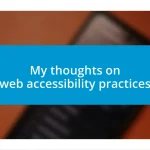Key takeaways:
- Modern CSS frameworks like Bootstrap and Tailwind CSS enhance productivity by providing pre-built components, utility classes, and responsive design capabilities that streamline development processes.
- Frameworks foster collaboration and consistency within teams, reducing styling chaos and ensuring uniformity across projects, as evidenced by experiences shared during collaborative efforts.
- Challenges such as learning curves and cluttered HTML highlight the importance of documentation and a trial-and-error approach, reinforcing resilience and deeper understanding in web development.

Introduction to modern CSS frameworks
Diving into modern CSS frameworks can be like stepping into a new world of design possibilities. I remember the first time I used Bootstrap; it was a game-changing experience. Suddenly, I could create responsive layouts without wrangling too much code, which made my projects feel more polished and professional.
As I explored frameworks like Tailwind CSS, I realized they weren’t just about aesthetics—they transformed my workflow. I found joy in utility-first styling, which allowed me to focus on building components rather than getting bogged down with stylesheets. Have you ever felt that exhilarating rush when everything just clicks into place with a few classes? It’s moments like these that emphasize how frameworks can simplify complex tasks.
Modern CSS frameworks often come packed with built-in components and grid systems, which can save you hours of development time. I vividly recall a project where I spent weeks on custom styles, only to discover that a framework’s predefined styles could have expedited my work. Isn’t it fascinating how leveraging these tools not only enhances productivity but also sparks creativity?

Benefits of using CSS frameworks
Using a CSS framework can greatly enhance the efficiency of your development process. For instance, when I worked on a client’s website, I remember how incredibly fast I could get a clean layout up and running with a few utility classes from Tailwind CSS. Instead of spending hours on aesthetics, I could focus on making the site functional and user-friendly. That sense of accomplishment was truly empowering.
Another point to consider is the consistency that a CSS framework brings to your projects. I’ve often found that without a framework, styling can quickly become chaotic, especially when working in a team. During one collaborative project, we used Bootstrap, which ensured that our designs were uniform across various components. It alleviated so much stress, knowing that everyone was on the same page and contributing to a cohesive look.
Lastly, these frameworks often come with extensive documentation and community support. I’ve leaned on documentation more times than I can count, especially when experimenting with new components. For instance, after diving into a complex layout with Bootstrap’s grid system, I found solace in the well-organized guides and forums. It’s reassuring to have such resources at your fingertips, providing a safety net for developers at any skill level.
| Benefit | Description |
|---|---|
| Efficiency | Accelerates development with pre-built components and utility classes. |
| Consistency | Ensures uniformity across designs, streamlining team collaboration. |
| Documentation | Offers extensive resources and community support for developers. |

Popular CSS frameworks overview
When considering popular CSS frameworks, Bootstrap often comes to mind first. It was one of the first frameworks I experimented with, and I’ll never forget how it made my layout designs feel light and seamless. The grid system and responsive classes allowed me to build websites that looked great on any device, and honestly, the thrill of seeing my designs come to life with just a couple of classes was incredible. That satisfaction of achieving a professional look without extensive time and effort is something every developer seeks.
Then there’s Tailwind CSS, which truly changed how I approach styling. The utility-first methodology resonated with me, especially during a particularly busy project last year. Instead of battling overclass names or relying on verbose stylesheets, I streamlined my workflow. I genuinely felt a rush every time I added a utility class that transformed the design in real-time. Here’s a brief overview of some popular CSS frameworks I’ve encountered:
- Bootstrap: Known for its responsive grid system and pre-designed components, I found it invaluable for projects requiring quick turnaround times.
- Tailwind CSS: Its utility-first approach empowers developers to create bespoke designs without being limited by predefined components, giving me a creative outlet.
- Foundation: I’ve admired its strong focus on accessibility and flexibility, which can be a game-changer for larger projects where user experience is paramount.
- Bulma: A straightforward CSS framework that emphasizes simplicity, perfect for those days when I just want to get to the heart of the design without unnecessary complexity.
Each framework offers unique features that cater to different project needs, reminding me how crucial it is to choose the right tool for the job.

My journey with Bootstrap
My journey with Bootstrap began during my first significant web development project. I was tasked with creating a corporate website for a startup, and I felt a mix of excitement and anxiety. As I dove into the Bootstrap documentation, I discovered how intuitive the grid system was. It felt like I had discovered a cheat code; suddenly, I could lay out the site in a way that was visually appealing and responsive, all while still learning the ropes of web design.
One particular moment stands out to me. I was struggling to implement a navbar that looked great on both desktop and mobile. Frustration was creeping in as I felt overwhelmed. But then, I decided to rely on Bootstrap’s pre-built components. Within minutes, I had a sleek, functional navbar that was consistent across devices. The relief was palpable! It made me realize how powerful Bootstrap could be in minimizing my stress as a relatively novice developer.
As I grew more confident, I realized that Bootstrap wasn’t just a tool; it had become part of my workflow. I often found myself suggesting it to colleagues and even friends starting their own web projects. It wasn’t just the ease of using it that I loved; it was the way it fostered creativity. With Bootstrap handling the fundamentals, I could focus on more intricate design elements, something that genuinely invigorated my passion for web design. Isn’t it fascinating how a framework can spark creativity rather than stifle it?

Exploring Tailwind CSS functionalities
Tailwind CSS opened up a world of possibilities for me with its utility-first design philosophy. I still remember the first time I saw a project come to life solely by applying a series of utility classes. It was exhilarating! Instead of wrestling with long CSS files and clashing styles, I embraced the joy of building directly in my HTML. Every time I added a new class, a small part of my design was instantly transformed, and that feedback loop kept me engaged and inspired.
One of my favorite features of Tailwind is its customization ability. I vividly recall working late into the night on a project and realizing that the default colors didn’t match the branding. Instead of panicking, I dove into the configuration file. In mere minutes, I had tailored a palette that perfectly aligned with the company’s identity. This flexibility not only saved time but also deepened my connection to the project as my unique design choices flourished.
Of course, discovering Tailwind’s responsiveness was a game changer, too. I fondly remember a client project where the layout needed to adapt seamlessly across devices. Using Tailwind, I quickly employed responsive utility classes that did the heavy lifting for me. Thankfully, I could enjoy the satisfaction of creating a beautifully functional site without losing precious hours fine-tuning media queries. Isn’t it amazing how the right tools can elevate our craft as developers?

Practical examples of CSS frameworks
I’ve had some memorable encounters with Bulma CSS in my recent projects. I distinctly recall building a personal portfolio site where I craved something lightweight yet powerful. Upon diving into Bulma, the simplicity of its class structure won me over immediately. It felt like a breath of fresh air, allowing me to focus on my work without the overhead of complicated configurations. The columns and card components simplified the layout, making it a breeze to showcase my work beautifully. Isn’t it funny how a straightforward framework can amplify creativity and productivity at once?
Another framework that made a significant impact on my approach was Foundation. I remember a collaborative project where we needed to develop a complex web app with intricate layouts. Foundation’s responsive design capabilities genuinely saved us. I was quite astonished by how quickly we could set up a complicated grid system. The introduction of advanced components, like the responsive tabs and flexible media queries, allowed us to transform our design vision into reality. It really struck me how having a solid framework in the background can change the way teams communicate and innovate.
Let’s not forget about Materialize CSS, which was a delightful exploration for me. I specifically remember a project where aesthetic appeal was a top concern. The material design principles offered by Materialize felt like they elevated the user experience significantly. Using its vibrant color palettes and interactive elements was addictive! I loved how it brought that smooth, tactile feeling to the interface. I often found myself gazing at the final product, amazed at how the framework made it so easy to achieve a polished look. Have you ever experienced that sense of satisfaction when everything just clicks into place? It’s moments like those that truly highlight the value of CSS frameworks in our development journey.

Challenges faced and lessons learned
Working with modern CSS frameworks has certainly come with its own set of challenges. One time, while using Tailwind CSS for a client’s project, I faced a dilemma with class naming conventions. Sometimes I felt overwhelmed by the myriad of utility classes available. It made me wonder: How do I decide which ones to use without making the HTML look cluttered? I learned that focusing on the structure of my components and categorizing utility classes by function allowed me to maintain clarity and create cohesive layouts.
Another hurdle I encountered was the learning curve associated with each framework’s specific syntax and features. I had my share of frantic moments trying to debug why a particular style wasn’t applied as I expected. I remember a frustrating afternoon with Bulma, where a class misuse led to a layout disaster. After some deep thinking, I realized that diligent documentation review offered a wealth of solutions. Embracing that approach not only solved my immediate problems but also empowered me with greater confidence in using frameworks moving forward.
Reflection has been key as I navigated through these frameworks. One significant lesson is the importance of trial and error. I remember my first attempt with Foundation, where I miscalculated row and column configurations, resulting in a jumbled layout. It felt disheartening at that moment, but after several adjustments and experimentation, I ended up with a system that was visually appealing and functional. This experience taught me resilience in the face of setbacks, reinforcing that mistakes often pave the way for deeper understanding and creativity. Have you ever found yourself in a similar situation where failure shaped your growth? It’s a powerful reminder that the path to mastery is often paved with challenges.












